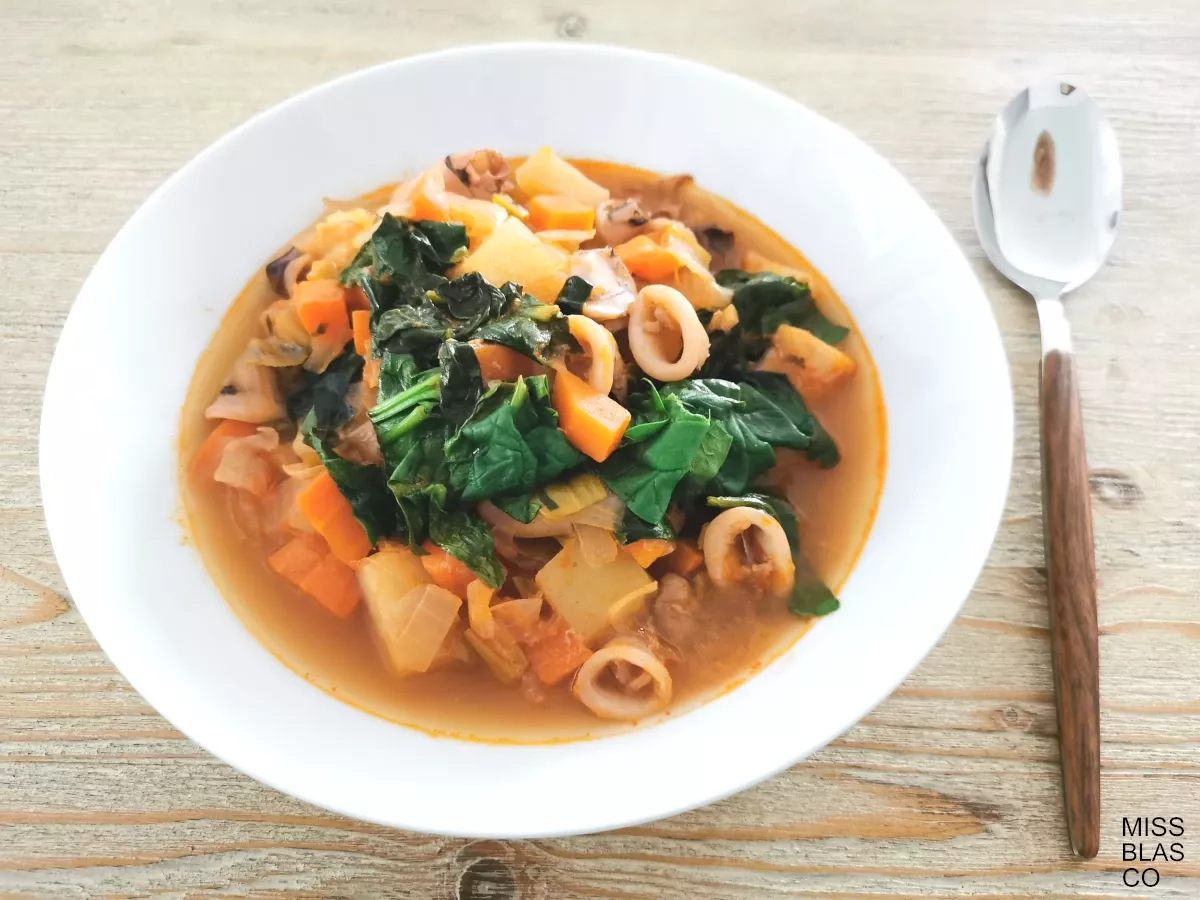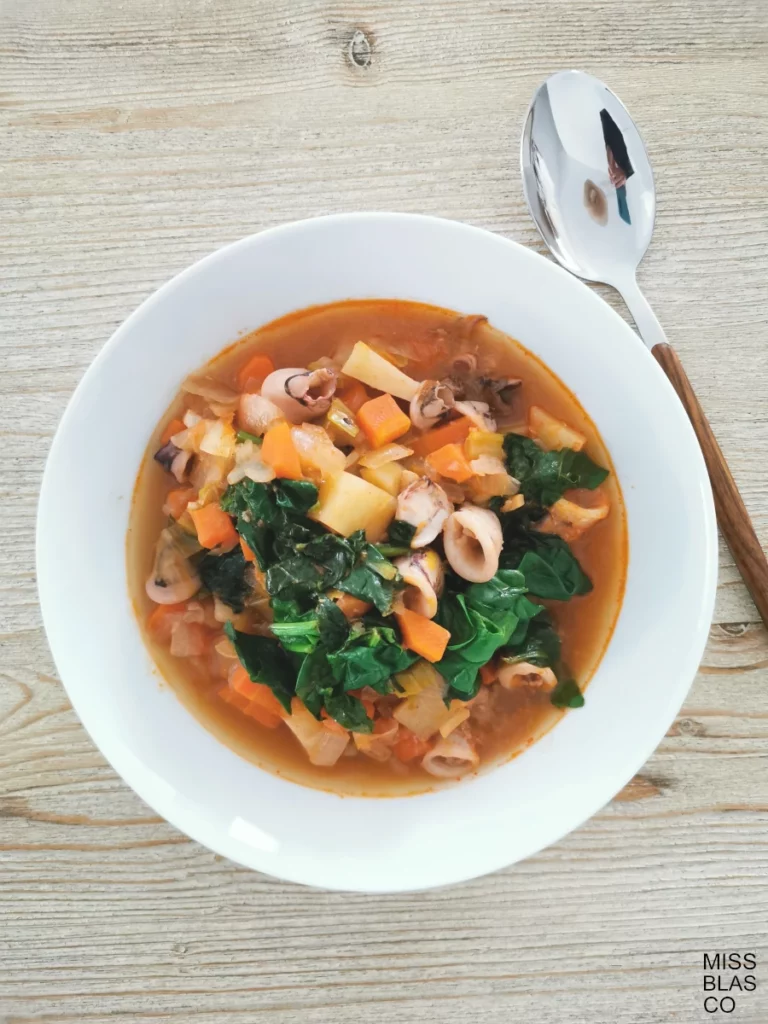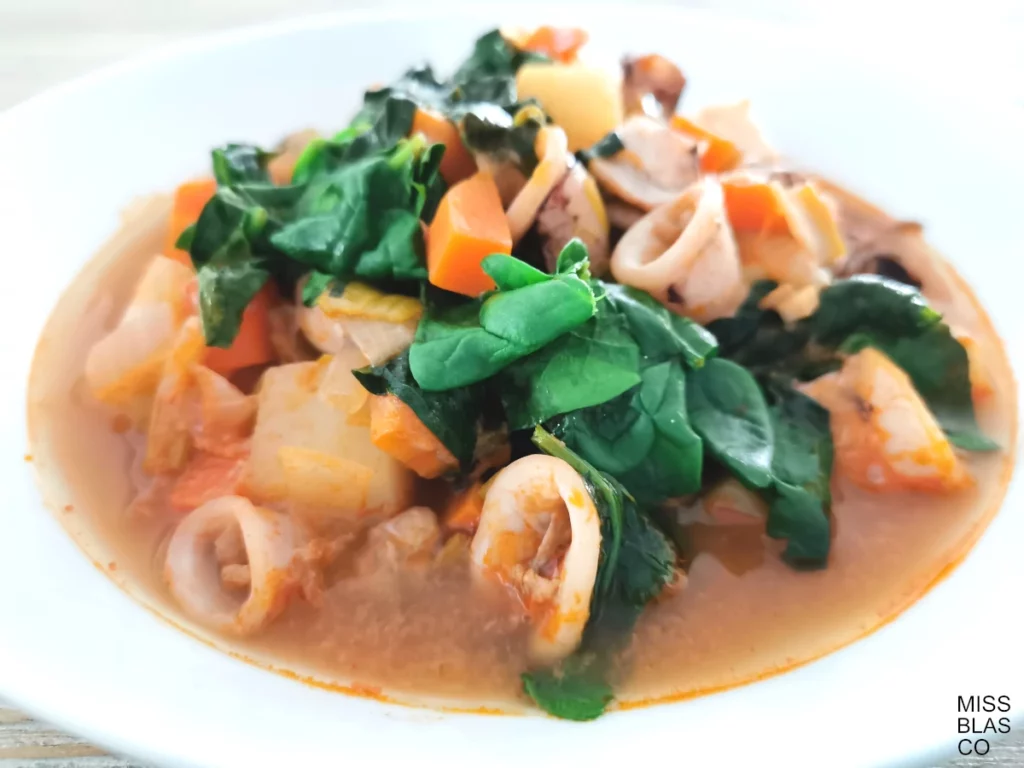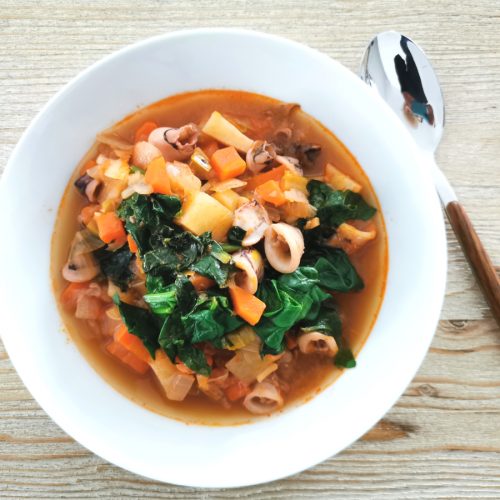
Squid and Vegetable Stew
Squid and Vegetable Stew: A Nutritious and Comforting Recipe
When the weather calls for something warm and nourishing, few dishes are as satisfying as a good stew. This squid and vegetable stew is simple to prepare, packed with nutrients, and makes for a comforting meal that supports a balanced diet. Beyond the recipe itself, I want to share the nutritional properties of squid and the vegetables included, so you not only know how to cook it but also why it is beneficial for your health.
Why stews are so good for you
I have always thought of stews as fuel for the body. A bowl of warm, wholesome food is like energy for an engine—it keeps you going, restores balance, and provides a deep sense of well-being.
Stews combine several food groups in one dish: lean protein, fiber-rich vegetables, and often a nutrient-packed broth. They are filling without being heavy, and if prepared with fresh ingredients and minimal oil, they become a cornerstone of healthy eating.
This squid stew is a perfect example. It only takes a few simple ingredients, it is easy to digest, and it brings together flavor and nutrition in the same pot.
Nutritional benefits of squid
Squid is the star ingredient in this recipe. It belongs to the group of cephalopods, along with cuttlefish and octopus, and has been consumed in Mediterranean and Asian cuisines for centuries. Its main nutritional highlights include:
- High-quality protein: Squid provides lean protein, essential for muscle repair, immune function, and energy.
- Low in fat: Unlike many other sources of protein, squid contains very little fat, making it suitable for those watching their caloric intake.
- Rich in minerals: It is an excellent source of copper, selenium, phosphorus, zinc, magnesium, and potassium. These minerals support metabolism, thyroid function, and heart health.
- Vitamins: Squid is rich in B vitamins (B2, B3, B12), which play a role in energy metabolism and nervous system health, as well as a modest amount of vitamin C.
- Cholesterol content: It is true that squid contains cholesterol, but moderate consumption, about once a week, is perfectly safe within a balanced diet.
For those concerned about seafood safety, squid is considered a low-mercury food, making it a safer choice compared to larger fish.
Squid is low in fat and high in protein, making it a lean and nutritious choice.
Why vegetables matter in this stew
The beauty of this stew lies in its combination of vegetables, which provide fiber, antioxidants, and extra nutrients. Let’s take a look:
- Carrot: Adds natural sweetness and is a good source of beta-carotene, an antioxidant converted into vitamin A that supports vision and immunity.
- Onion and leek: Provide depth of flavor and prebiotic fibers that nourish the gut microbiota.
- Garlic: Known for its antibacterial and anti-inflammatory properties.
- Spinach: Adds color, texture, and nutrients such as iron, folate, and vitamin K.
- Potato (optional): A natural thickener for the stew, providing energy in the form of complex carbohydrates.
Together, these vegetables create a flavorful base that balances the lean protein of squid, making this dish both complete and satisfying.

Healthy cooking methods for squid
One of the most important aspects of preparing squid is how you cook it. The healthiest methods are stewing, grilling, or baking. Frying, while tasty, is not recommended for regular consumption because the oil oxidizes at high temperatures, creating harmful compounds.
If you enjoy fried squid, a good alternative is to prepare it in the oven or in an air fryer with a lighter homemade batter. But for an everyday option, stewing is ideal: it keeps the squid tender, preserves nutrients, and allows the flavors of the vegetables and broth to shine.
Stewing vegetables with squid provides antioxidants, fiber, and minerals in one dish.
Step-by-step recipe: Squid and Vegetable Stew
Ingredients (serves 2–3):
- 450 g cleaned squid, cut into pieces (fresh or frozen)
- 1 carrot
- 1 onion
- 1 leek
- 1 medium potato (optional)
- 100 g fresh spinach
- 1 garlic clove
- 1 tsp tomato paste (optional)
- 1 tbsp sugar-free tomato sauce
- 250 ml fish stock (homemade or store-bought)
- 2 tbsp extra virgin olive oil
- 1 pinch sea salt
- 1 pinch white pepper
Instructions:
- Start by preparing a sofrito with the onion, leek, carrot, and crushed garlic in olive oil. Season lightly with salt.
- Add the potato, peeled and diced into small cubes.
- Stir in the tomato paste and tomato sauce. Cook for a couple of minutes.
- Add the squid pieces and the fish stock. Cover and let simmer over low heat for about 15 minutes.
- Add the spinach leaves and cook for 5 more minutes.
- Adjust seasoning with salt and white pepper.
- Let the stew rest for about 30 minutes before serving for best flavor.
- This dish pairs well with a slice of whole-grain bread or a fresh salad.

Practical tips for best results
If using frozen squid, thaw it slowly in the refrigerator to maintain texture.
Avoid overcooking the squid, as it may become rubbery. Keep cooking times short and gentle.
For a thicker stew, mash a few cubes of potato directly in the pot.
To enhance flavor, try adding a splash of white wine before adding the stock.
Fresh parsley or cilantro can be used as garnish for extra freshness.
A simple recipe that combines comfort and health, perfect for everyday cooking.
Cooking healthy meals does not have to be complicated. With a few fresh ingredients and a simple method, you can prepare a nutrient-rich stew that fits into any balanced eating plan. This squid and vegetable stew is proof that comfort food can also be light, nourishing, and good for your health.
If you enjoy Mediterranean-style dishes, make this stew part of your weekly menu. It is quick, versatile, and provides both energy and essential nutrients.
Explore more healthy stews:

GUISO DE CALAMARES CON VERDURAS
Ingredients
- 450 g calamar limpio troceado congelado
- 1 zanahoria
- 1 cebolla
- 1 puerro
- 1 patata mediana opcional
- 100 g espinacas frescas
- 1 diente de ajo
- 1 cdita pasta de tomate concentrado opcional
- 1 cda salsa de tomate sin azúcar
- 250 ml fondo de pescado casero o de compra
- 1 pizca sal marina
- 1 pizca pimienta blanca
- 2 cdas aceite de oliva virgen extra
Instructions
- Prepara un sofrito con las verduras, la cebolla, el puerro, la zanahoria y el ajo machacado. Sazona.
- Añade la patata cortada en cubos.
- Añade la pasta de tomate y la salsa de tomate.
- Ahora el calamar y el caldo y deja cocer unos 15 minutos, tapado y a fuego bajo.
- Por último añade las espinacas y deja cocer 5 minutos más.
- Rectifica de sal y pimienta. Ya tienes tu guiso listo, si reposa unos 30 minutos antes de tomarlo mejor.